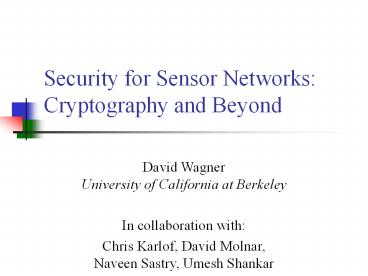Security for Sensor Networks: Cryptography and Beyond - PowerPoint PPT Presentation
Title:
Security for Sensor Networks: Cryptography and Beyond
Description:
Security for Sensor Networks: Cryptography and Beyond David Wagner University of California at Berkeley In collaboration with: Chris Karlof, David Molnar, – PowerPoint PPT presentation
Number of Views:41
Avg rating:3.0/5.0
Title: Security for Sensor Networks: Cryptography and Beyond
1
Security for Sensor NetworksCryptography and
Beyond
- David WagnerUniversity of California at Berkeley
- In collaboration with
- Chris Karlof, David Molnar,Naveen Sastry, Umesh
Shankar
2
Learn From History
Lets get it right the first time!
3
Sensor Nets So What?
- Whats different about sensor nets?
- Stringent resource constraints
- Insecure wireless networks
- No physical security
- Interaction with the physical environment
4
Where Are We Going?
- Some research challenges in sensor net security
- Securing the communication link
- Securing distributed services
- Tolerating captured nodes
5
I. Communications Security The TinySec
Architecture
It doesnt matter how good your crypto is if it
is never used.
6
(No Transcript)
7
(No Transcript)
8
(No Transcript)
9
TinySec Design Philosophy
- The lesson from 802.11
- Build crypto-security in, and turn it on by
default! - TinySec Design Goals
- 1. Encryption turned on by default
- 2. Encryption turned on by default
- 3. Encryption turned on by default
- ? Usage must be transparent and intuitive
- ? Performance must be reasonable
- 4. As much security as we can get, within these
constraints
10
Challenges
- Must avoid complex key management
- TinySec must be super-easy to deploy
- Crypto must run on wimpy devices
- Were not talking 2GHz P4s here!
- Dinky CPU (1-4 MHz), little RAM (? 256 bytes),
lousy battery - Public-key cryptography is right out
- Need to minimize packet overhead
- Radio is very power-intensive1 bit transmitted
? 1000 CPU ops - TinyOS packets are ? 28 bytes long
- Cant afford to throw around an 128-bit IV here,
a 128-bit MAC there
11
Easy Key Management
network
k
basestation
k
k
k
k
k
Making key management easy global shared keys
12
Be Easy to Deploy
App
App
SecureGenericComm
GenericComm
Radio
Radio
Making deployment easyplug-n-play crypto
link-layer security
13
Perform Well on Tiny Devices
Radio Stack MicaHighSpeedRadioM/ CC1000RadioIntM
TinySecM
CBC-ModeM
CBC-MACM
SkipJackM
- Use a block cipher for both encryption
authentication - Skipjack is good for 8-bit devices low RAM
overhead
14
Minimize Packet Overhead
len
AM
IV
data
MAC
dest
Key Differences No CRC -2 bytes No group ID
-1 bytes MAC 4 bytes IV 4 bytes Total
5 bytes
Minimize overhead cannibalize, cheat, steal
15
Tricks for Low Overhead
- CBC mode encryption, with encrypted IV
- Allows flexible IV formatting4 byte counter,
cleartext hdr fields (dest, AM type,
length)gets the most bang for your birthday
buck - IV robustness Even if IV repeats, plaintext
variability may provide an extra layer of defense - Ciphertext stealing avoids overhead on
variable-length packets - CBC-MAC, modified for variable-length packets
- Small 4-byte MAC trades off security for
performance the good news is that low-bandwidth
radio limits chosen-ciphertext attacks - Can replace the application CRC checksum saves
overhead - On-the-fly crypto overlap computation with I/O
16
More Tricks Features
- Early rejection for packets destined elsewhere
- Stop listening decrypting once we see dst addr
? us - Support for mixed-mode networks
- Interoperable packet format with unencrypted
packets,so network can carry both encrypted
unencrypted traffic - Crypto only where needed ? better performance
- Length field hack steal 2 bits to distinguish
between modes - Support fine-grained mixed-mode usage of TinySec
- Add 3 settings no crypto, integrity only,
integritysecrecy - These come with performance tradeoffs
- Select between settings on per-application or
per-packet basis
17
More Performance Tricks
- App-level API for end-to-end encryption
- TinySec focuses mainly on link-layer crypto,but
end-to-end crypto also has value - End-to-end secrecy enables performance
optimizations (dont decrypt re-encrypt at
every hop), enables more sophisticated per-node
keying, but incompatible with in-network
transformation and aggregation thus, not always
appropriate - End-to-end integrity less clear-cut, due to DoS
attacks
18
TinySec Current Status
- Design implementation stable
- Released in TinyOS 1.1
- Integration with RFM Chipcon radio stacks
supports nesC 1.1 - Simple key management should be transparent
- Several external users
- Including SRI, BBN, Bosch
19
TinySec Evaluation
- Wins
- Performance is ok
- Integration seems truly easy
- Neutral
- Out of scope per-node keying, re-keying,
sophisticated key mgmt PKI secure link-layer
ACKs - No security against insider attacksWhat if a
node is captured, stolen, or compromised? - Losses
- Not turned on by default in TinyOS yet ?































